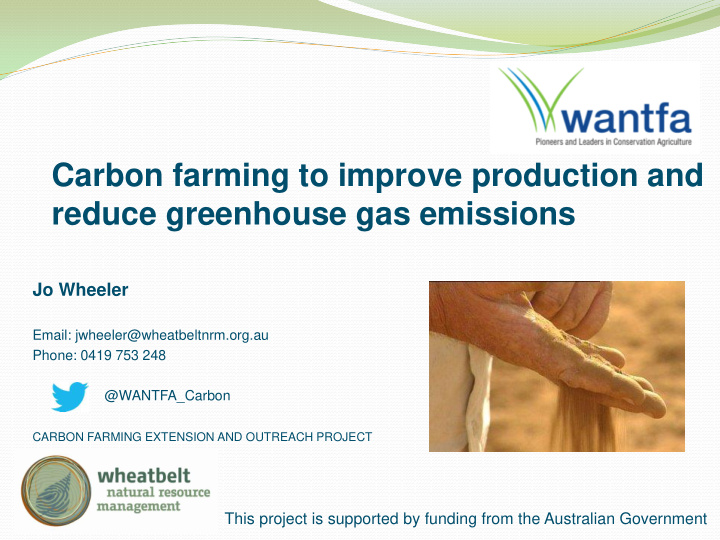



Carbon farming to improve production and reduce greenhouse gas emissions Jo Wheeler Email: jwheeler@wheatbeltnrm.org.au Phone: 0419 753 248 @WANTFA_Carbon CARBON FARMING EXTENSION AND OUTREACH PROJECT This project is supported by funding from the Australian Government
What is carbon farming? The capture and storage of carbon in vegetation and soil or reducing greenhouse gas emissions from agricultural practices
Greenhouse gas emissions from agriculture 0.2% Rice cultivation 1% Burning Agriculture contributes : agricultural residues 13% Burning savannas • 16% of all Australia’s GHG • 58% of all methane production 17% (or 10% of national GHG emissions) Agricultural soils • 86% of all nitrous oxide 65% Enteric production 4% Manure fermentation (or 3% of national GHG emissions) management
Global warming potential CO 2 -e Carbon dioxide – CO2 Methane – CH4 Nitrous oxide – N2O
On farm sources of GHG emissions Fuel usage CO2 Cultivation CO2 Soil Organic Matter CO2 Crop residue breakdown CO2 N application N2O Burning stubbles N2O CH4 Biological N fixation N2O Waterlogging CH4 Livestock emissions CH4 Manure management CH4
What can you do as carbon farmers? Understand soil condition and constraints Adjust fertiliser application Manage soil compaction in paddocks Use different crop rotations Plant areas of unproductive land to sequester carbon Summer cropping Control waterlogging in paddocks Change livestock management
Adaptation and mitigation Adaptation: Actions undertaken to reduce the adverse consequences of climate change, as well as to benefit from any opportunities. Aim to reduce the risks and impacts of climate stresses Changing what we do, to get what we want Mitigation: Reduce the magnitude of our contribution to climate change. Mitigation refers to strategies to reduce greenhouse gas and enhance greenhouse gas sinks.
Emissions Reduction Fund Australian Government’s plan to efficiently and effectively source low cost emissions reductions Designed to reduce greenhouse gas emissions and store carbon in soil and vegetation. 1 tonne of CO ₂ -e reduced = 1 ACCU (Australian Carbon Credit Unit) ACCUs can be sold at auction or privately into the secondary market ACCUs can be an extra source of income
Participating in the Emissions Reduction Fund Run your Apply to Apply for a project and Sell your Am I eligible? participate contract claim ACCUs ACCUs Start your project once registered Source: Clean Energy Regulator
Soil Carbon Method Project management activities in soil carbon projects A soil carbon project must involve at least one of these project management activities : 1. Sustainable intensification involves at least 2 of the following management actions (a) nutrient management; b) soil acidity management; (c) new irrigation; (d) pasture renovation. 2. Stubble retention involves undertaking the management action of retaining stubble in a carbon estimation area after a crop is harvested. 3. Conversion to pasture involves undertaking the management actions of establishing and maintaining pasture in a carbon estimation area. Source: https://www.comlaw.gov.au/Details/F2015L01163/Html/Text#_Toc256000455
Stubble Retention Map Sustainable Intensification Map CF Mapping Tool Marginal benefit Conversion to Pasture Map (yellow) Some benefit (orange) More benefit (brown) Ineligible land
Sequestration Values from FullCAM modelling
Carbon Payments for Soils Method Sustainable intensification activities SA2 Region on CFI map Sequestration Value Price ( t/CO₂ -e/yr) $/ha/yr $13.95 $1.53 0.11 tCO ₂ -e/ha/yr Yellow (0.03 tonne C/ha/yr) $7 $0.77 $13.95 $8.23 0.59 tCO ₂ -e/ha/yr Orange (0.16 tonne C/ha/yr) $7 $4.13 $13.95 $23.02 1.65 tCO ₂ -e/ha/yr Brown (0.44 tonne C/ha/yr) $7 $11.55
Carbon Payments for Soils Method Conversion to Pastures SA2 Region on CFI map Sequestration Value Price ( t/CO₂ -e/yr) $/ha/yr $13.95 $3.07 0.22 tCO ₂ -e/ha/yr Yellow (0.06 tonne C/ha/yr) $7 $1.54 $13.95 $6.14 0.44 tCO ₂ -e/ha/yr Orange (0.12 tonne C/ha/yr) $7 $3.08 $13.95 $11.72 0.84 tCO ₂ -e/ha/yr Brown (0.23 tonne C/ha/yr) $7 $5.88
Carbon Payments for Soils Method Stubble Retention SA2 Region on CFI map Sequestration Value Price ( t/CO₂ -e/yr) $/ha/yr $13.95 $0.98 0.07 tCO ₂ -e/ha/yr Yellow (0.02 tonne C/ha/yr) $7 $0.49 $13.95 $4.05 0.29 tCO ₂ -e/ha/yr Orange (0.08 tonne C/ha/yr) $7 $2.03 $13.95 $10.18 0.73 tCO ₂ -e/ha/yr Brown (0.20 tonne C/ha/yr) $7 $5.11
Want to know more? Jo Wheeler Email: jwheeler@wheatbeltnrm.org.au Phone: 0419 753 248 @WANTFA_Carbon Wantfa.com.au/projects CARBON FARMING EXTENSION AND OUTREACH PROJECT This project is supported by funding from the Australian Government
Recommend
More recommend